中英双语中国传统节日介绍
中国传统节日及传说中英文对照
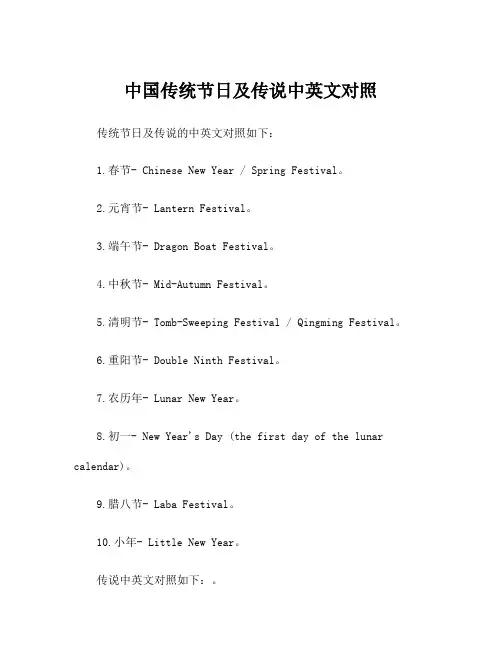
中国传统节日及传说中英文对照传统节日及传说的中英文对照如下:1.春节- Chinese New Year / Spring Festival。
2.元宵节- Lantern Festival。
3.端午节- Dragon Boat Festival。
4.中秋节- Mid-Autumn Festival。
5.清明节- Tomb-Sweeping Festival / Qingming Festival。
6.重阳节- Double Ninth Festival。
7.农历年- Lunar New Year。
8.初一- New Year's Day (the first day of the lunar calendar)。
9.腊八节- Laba Festival。
10.小年- Little New Year。
传说中英文对照如下:。
1.嫦娥奔月- Chang'e Flying to the Moon。
2.神话五岳- The Myth of the Five Sacred Mountains。
3.龙舟竞渡- The Legend of Dragon Boat Racing。
4.桃花源- The Peach Blossom Spring。
5.白蛇传- The Legend of White Snake。
6.八仙过海- The Eight Immortals Cross the Sea。
7.牛郎织女- The Cowherd and the Weaver Girl。
8.茶的传说- The Legend of Tea。
9.粽子的传说- The Legend of Zongzi。
10.红烧肉的传说- The Legend of Braised Pork Belly。
中国主要节日中英文对照表
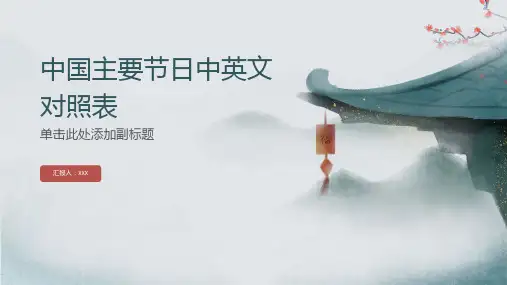
教师节(Teachers' Day)
第四章
中国佛教节日
佛诞节(Buddha's Birthday)
节日时间:农历四月初八
节日起源:纪念释迦牟尼 佛诞生
节日习俗:浴佛、放生、 吃斋、诵经
节日意义:弘扬佛教文化, 传承佛教精神
成道节(Enlightenment Day)
节日时间:农历十二月初八
节日习俗:吃腊八粥、放生、诵经、 拜佛
添加标题
添加标题
节日起源:纪念释迦牟尼成道
添加标题
添加标题
节日意义:弘扬佛教文化,传承佛 教精神
涅槃节(Nirvana Day)
节日时间:农历二月十五日
节日意义:纪念释迦牟尼佛涅槃的日子
节日习俗:诵经、拜佛、放生、布施等
与其他佛教节日的关系:与佛陀诞生日(Vesak Day)、佛陀成道日(Buddha Day)并称 为佛教三大节日
节日意义:庆祝春 天的到来,祈求丰 收
节日活动:祭祀、 歌舞、游戏
特色美食:糯米饭 、粽子、米酒
第三章
中国现代节日
劳动节(Labor Day)
节日时间:每年5月1日 节日意义:庆祝劳动人民的辛勤工作和贡献 节日活动:放假、旅游、购物、家庭聚会等 相关词汇:劳动、工人、假期、庆祝、贡献等
国庆节(National Day)
节日意义:庆祝中华人民共 和国成立
节日活动:举行盛大的阅兵 仪式和庆祝活动
节日时间:10月1日
节日习俗:挂国旗、唱国歌、 放烟花、旅游等
儿童节(Children's Day)
节日时间:6 月1日ຫໍສະໝຸດ 节日意义:庆 祝儿童的快乐
和成长
节日活动:亲 子活动、学校 庆祝活动、儿 童才艺展示等
中国传统节日中英文对照
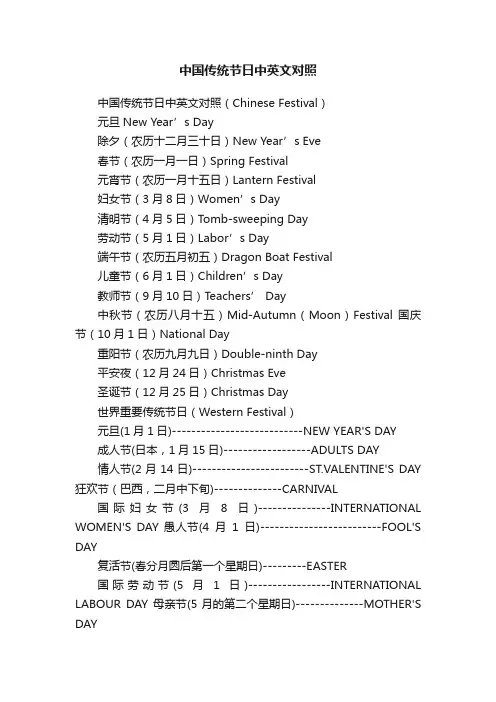
中国传统节日中英文对照中国传统节日中英文对照(Chinese Festival)元旦New Year’s Day除夕(农历十二月三十日)New Year’s Eve春节(农历一月一日)Spring Festival元宵节(农历一月十五日)Lantern Festival妇女节(3月8日)Women’s Day清明节(4月5日)Tomb-sweeping Day劳动节(5月1日)Labor’s Day端午节(农历五月初五)Dragon Boat Festival儿童节(6月1日)Children’s Day教师节(9月10日)Teachers’ Day中秋节(农历八月十五)Mid-Autumn(Moon)Festival 国庆节(10月1日)National Day重阳节(农历九月九日)Double-ninth Day平安夜(12月24日)Christmas Eve圣诞节(12月25日)Christmas Day世界重要传统节日(Western Festival)元旦(1月1日)---------------------------NEW YEAR'S DAY成人节(日本,1月15日)------------------ADULTS DAY情人节(2月14日)------------------------ST.VALENTINE'S DAY 狂欢节(巴西,二月中下旬)--------------CARNIVAL国际妇女节(3月8日)---------------INTERNATIONAL WOMEN'S DAY 愚人节(4月1日)-------------------------FOOL'S DAY复活节(春分月圆后第一个星期日)---------EASTER国际劳动节(5月1日)-----------------INTERNATIONAL LABOUR DAY 母亲节(5月的第二个星期日)--------------MOTHER'S DAY国际儿童节(6月1日)-------------INTERNATIONAL CHILDREN''S DAY 父亲节(6月的第三个星期日)--------------FATHER'S DAY端午节(阴历5月5日)---------------------DRAGON BOAT FESTIVAL 中秋节(阴历8月15日)--------------------MOON FESTIVAL教师节(中国,9月10日)------------------TEACHER'S DAY敬老节(日本,9月15日)------------------OLD PEOPLE'S DAY 南瓜节(北美10月31日)-------------------PUMPKIN DAY鬼节(万圣节除夕,10月31日夜)-----------HALLOWEEN万圣节(11月1日)------------------------HALLOWMAS感恩节(美国,11月最后一个星期4)--------THANKSGIVING圣诞除夕(12月24日)---------------------CHRISTMAS EVE圣诞节(12月25日)-----------------------CHRISTMAS DAD节礼日(12月26日)-----------------------BOXING DAY。
中国节日和纪念日大全中英文对照
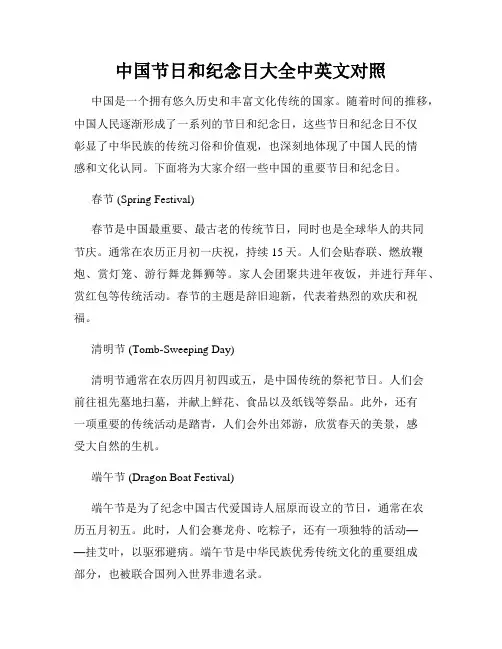
中国节日和纪念日大全中英文对照中国是一个拥有悠久历史和丰富文化传统的国家。
随着时间的推移,中国人民逐渐形成了一系列的节日和纪念日,这些节日和纪念日不仅彰显了中华民族的传统习俗和价值观,也深刻地体现了中国人民的情感和文化认同。
下面将为大家介绍一些中国的重要节日和纪念日。
春节 (Spring Festival)春节是中国最重要、最古老的传统节日,同时也是全球华人的共同节庆。
通常在农历正月初一庆祝,持续15天。
人们会贴春联、燃放鞭炮、赏灯笼、游行舞龙舞狮等。
家人会团聚共进年夜饭,并进行拜年、赏红包等传统活动。
春节的主题是辞旧迎新,代表着热烈的欢庆和祝福。
清明节 (Tomb-Sweeping Day)清明节通常在农历四月初四或五,是中国传统的祭祀节日。
人们会前往祖先墓地扫墓,并献上鲜花、食品以及纸钱等祭品。
此外,还有一项重要的传统活动是踏青,人们会外出郊游,欣赏春天的美景,感受大自然的生机。
端午节 (Dragon Boat Festival)端午节是为了纪念中国古代爱国诗人屈原而设立的节日,通常在农历五月初五。
此时,人们会赛龙舟、吃粽子,还有一项独特的活动——挂艾叶,以驱邪避病。
端午节是中华民族优秀传统文化的重要组成部分,也被联合国列入世界非遗名录。
中秋节 (Mid-Autumn Festival)中秋节是一个家庭团聚的节日,通常在农历八月十五。
人们会赏月、吃月饼、赏菊花等。
中秋节的核心是月亮,代表着团聚和祝福。
此外,也有丰富多样的民间故事和传说与中秋节相关联,如嫦娥奔月、吴刚伐桂等。
国庆节 (National Day)国庆节是中国的国家节日,于每年的十月一日庆祝,持续7天。
这是一个庆祝中华人民共和国成立的节日,人们会进行各种形式的庆祝活动,如升国旗仪式、阅兵式、文艺演出等。
国庆节是中国人民爱国主义情感的集中表达,也是对中华民族伟大历史和深厚文化底蕴的庆祝。
五四青年节 (Youth Day)五四青年节是为了纪念1919年五四运动而设立的节日,同时也是世界青年节。
中国传统节日(中英文对照)
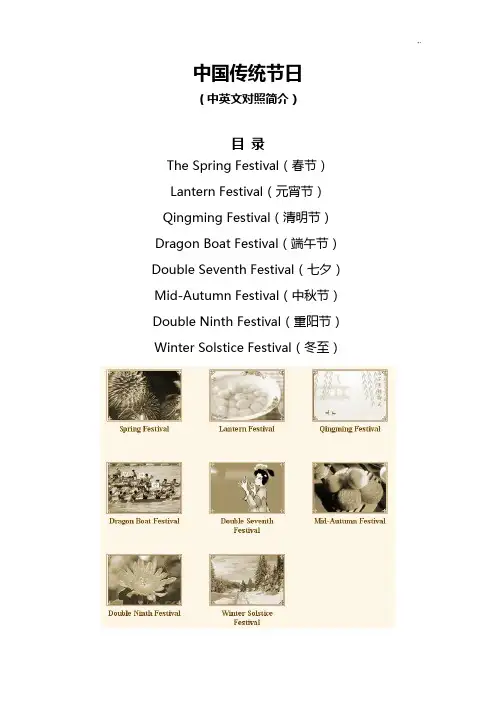
中国传统节日(中英文对照简介)目录The Spring Festival(春节)Lantern Festival(元宵节)Qingming Festival(清明节)Dragon Boat Festival(端午节)Double Seventh Festival(七夕)Mid-Autumn Festival(中秋节)Double Ninth Festival(重阳节)Winter Solstice Festival(冬至)The Spring Festival(春节)The first day of the first lunar month is the New Year in the Chinese lunar calendar. Among the traditional Chinese festivals, this is the most important and the most bustling. Since it occurs at the end of winter and the beginning of spring, people also call it the Spring Festival.Chinese have many traditional customs relating to the Spring Festival. Since the 23rd day of the 12th lunar montha, people start to prepare for the event. Every family will undertake thorough cleaning, do their Spring Festival shopping, create paper-cuts for window decoration, put up New Year picturesb, write Spring Festival coupletsc, make New Year cakesd, and also prepare all kinds of food to bid farewell to the old and usher in the new.New Year's Eve is the time for a happy reunion of all family members, when they sit around the table to have a sumptuous New Year's Eve dinner, talking and laughing, until daybreak, which is called "staying up to see the year out". When the bell tolls midnight on New Year's Eve, people eat dumplings. In ancient times, midnight was called zishi (a period of the day from 11 p.m. to 1 a.m.). Dumplings (jiaozi) are eaten because it sounds the same as "change of the year and the day" in Chinese.From the first day of the lunar year, people pay New Year calls on relatives and friends, which is an important custom for the Spring Festival.Setting off firecrackers is the favorite activity of children in the Spring Festival. According to legend, this could drive off evil spirits. The continuous sound of firecrackers can be heard everywhere, adding to the atmosphere of rejoicing and festivity.Many places hold temple fairs. The wonderful dragon lantern dance and the lion dance performances, along with various handicraft articles and local snacks attract thousands of people.With the development of the times, some changes have taken place inthe customs of spending the Spring Festival. For example, to prevent environmental pollution, many cities have banned firecrackers. But this does not have an impact on the happy atmosphere of the festival. On New Year's Eve, family members get together to have dinner while watching TV programs.For Chinese at home and abroad, the Spring Festival is always the most important festival.农历的正(zheng)月初一,是中国的农历新年。
中国传统节日英语简短
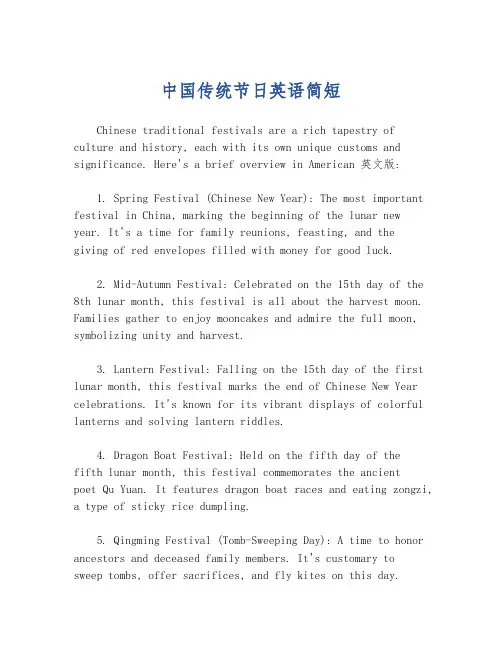
中国传统节日英语简短Chinese traditional festivals are a rich tapestry of culture and history, each with its own unique customs and significance. Here's a brief overview in American 英文版:1. Spring Festival (Chinese New Year): The most important festival in China, marking the beginning of the lunar new year. It's a time for family reunions, feasting, and thegiving of red envelopes filled with money for good luck.2. Mid-Autumn Festival: Celebrated on the 15th day of the 8th lunar month, this festival is all about the harvest moon. Families gather to enjoy mooncakes and admire the full moon, symbolizing unity and harvest.3. Lantern Festival: Falling on the 15th day of the first lunar month, this festival marks the end of Chinese New Year celebrations. It's known for its vibrant displays of colorful lanterns and solving lantern riddles.4. Dragon Boat Festival: Held on the fifth day of thefifth lunar month, this festival commemorates the ancientpoet Qu Yuan. It features dragon boat races and eating zongzi, a type of sticky rice dumpling.5. Qingming Festival (Tomb-Sweeping Day): A time to honor ancestors and deceased family members. It's customary tosweep tombs, offer sacrifices, and fly kites on this day.6. Double Ninth Festival (Chongyang Festival): Celebrated on the ninth day of the ninth lunar month, it's a day to appreciate the elderly and to climb mountains, symbolizing the avoidance of bad luck.7. Double Seventh Festival (Qixi Festival): Oftenreferred to as Chinese Valentine's Day, it celebrates the annual meeting of the Cowherd and the Weaver Girl, represented by the stars Altair and Vega.These festivals are not just dates on the calendar but are living traditions that continue to play a significantrole in the lives of many Chinese people, both in China and around the world.。
初中英语作文介绍中国传统节日
初中英语作文介绍中国传统节日(中英文实用版)Title: Traditional Chinese FestivalsChina is a country with a rich cultural heritage, and one of the most interesting aspects of Chinese culture is its array of traditional festivals.These festivals are an important part of Chinese life, celebrated by people all over the country.One of the most well-known Chinese festivals is the Spring Festival, also known as Chinese New Year.It is the most important festival in China, and it usually falls between late January and mid-February.During the festival, people decorate their homes with red lanterns and couplets, and gather with family to celebrate the coming of the new year.Fireworks and dragon and lion dances are also common during this time.Another important festival is the Dragon Boat Festival, which is celebrated on the fifth day of the fifth month of the Chinese calendar.This festival is in memory of the famous poet Qu Yuan.People eat sticky rice dumplings wrapped in bamboo leaves, and participate in dragon boat races to honor Qu Yuan's memory.The Mid-Autumn Festival is another popular Chinese festival, celebrated on the 15th day of the eighth month of the Chinese calendar.This festival is also known as the Moon Festival.People gather with family and friends to eat mooncakes, a type of pastry filled withsweet bean or lotus seed paste and sometimes with salted egg yolk.They also enjoy the full moon and share stories about the moon.Lastly, the Double Ninth Festival, also known as the Chongyang Festival, is celebrated on the ninth day of the ninth month of the Chinese calendar.This is a day for honoring ancestors and showing respect for the elderly.People often climb mountains and drink chrysanthemum wine, and some regions have the custom of flying kites.These are just a few examples of the many traditional Chinese festivals.Each festival has its own unique customs and traditions, and they are all important parts of Chinese culture.。
中国传统节日中英文
三. Dragon Boat Festival
Dragon Boat Festival is Fifth day of lunar month, Han Chinese traditional festivals.
Hale Waihona Puke customs of the Dragon Boat Festival
Eating zongzi--rice ball wrapped in bamboo leaves Dragon boat race
Dragon heads-raising Day 二月二
寒食节——the cold food day
寒食节,亦称“禁烟 节”、“冷节”、 “百五节”。在每年 四月四日,清明节的 前一天。这一日,禁 烟火,所以人们不会 煮热饭热菜,而只吃 冷食。寒食节前后绵 延两千余年,曾被称 为民间第一大祭日。
Tomb-sweeping Day
The custom of the Ching Ming Festival
We will fly a kite in the field, Enjoy the beautiful spring.
清明上河图
Qingming worship
Ching Ming is the most important festival of sacrifice, we come to worship and grave to commemorate our ancestors
eat dumplings
to stay up late all night on New Year‘s Eve 守岁
to set off firecrackers
中国传统节日中英文对照
中国传统节日中英文对照中国是一个拥有丰富传统文化的国家,其中的节日更是令人瞩目。
中国传统节日丰富多彩,每一个节日都承载着独特的文化内涵和意义。
以下将对一些中国传统节日进行中英文对照,并简短地介绍其由来和庆祝方式,以便更好地了解中国传统文化。
春节 - Chinese New Year春节是中国最重要的传统节日,通常在公历1月底或2月初庆祝。
这个节日以庆祝农历新年为主题,也称为农历新年。
春节庆祝活动包括贴春联、贴窗花、包饺子、赏花灯和放鞭炮。
人们还会走亲访友,互赠红包,以祝贺新年的到来。
元宵节 - Lantern Festival元宵节是农历新年的最后一个节日,通常在公历2月中旬或3月初庆祝。
这一天,人们会在夜晚放飞孔明灯,同时还有猜灯谜的传统活动。
元宵节的象征是汤圆,人们会吃汤圆以庆祝团圆和美好的未来。
清明节 - Tomb-sweeping Festival清明节通常在公历4月4日或5日之间举行。
这是一个纪念祖先和扫墓的节日。
人们会去墓地祭奠祖先,整理坟墓,悼念逝去的亲人。
此外,人们还会踏青郊游,欣赏春天的美景。
端午节 - Dragon Boat Festival端午节是一个具有悠久历史的节日,通常在公历6月初庆祝。
这个节日源于纪念古代爱国诗人屈原,也是一项庆祝夏天到来的活动。
人们会参加龙舟赛、包粽子和挂艾草。
象征食物是粽子,人们吃粽子以保护自己免受邪恶和疾病的侵袭。
中秋节 - Mid-Autumn Festival中秋节是农历八月十五,通常在公历9月底或10月初庆祝。
这个节日庆祝秋天的丰收和团圆。
人们会赏月、品尝月饼以及举办家庭聚会。
月饼是中秋节的特色食物,馅料的种类多样,寓意着团圆和祝福。
重阳节 - Double Ninth Festival重阳节通常在公历9月初或10月底庆祝,也被称为老人节。
此节日的由来与古代传说有关,人们会爬山、采菊、追溯阳光,并祝福年长的亲人和朋友。
重阳节也是缅怀祖先和尊重老年人的时间。
中国节日介绍英文版
中国节日介绍英文版中国节日介绍英文版一、农历节日农历正月初一春节(the Spring Festival)农历正月十五元宵节(Lantern Festival)农历五月初五端午节(the Dragon-Boat Festival)农历七月初七乞巧节(中国情人节)(Double-Seventh Day) 农历八月十五中秋节(the Mid-Autumn Festival)农历九月初九重阳节(the Double Ninth Festival)农历腊月初八腊八节(the laba Rice Porridge Festival)二、阳历节日1月1日元旦(New Year's Day)2月2日世界湿地日(World Wetlands Day)2月14日情人节(Valentine's Day)3月3日全国爱耳日3月5日青年志愿者服务日3月8日国际妇女节(International Women' Day)3月9日保护母亲河日3月12日中国植树节(China Arbor Day)3月14日白色情人节(White Day)3月14日国际警察日(International Policemen' Day)3月15日世界消费者权益日(World Consumer Right Day)3月21日世界森林日(World Forest Day)3月21日世界睡眠日(World Sleep Day)3月22日世界水日(World Water Day)3月23日世界气象日(World Meteorological Day)3月24日世界防治结核病日(World Tuberculosis Day)4月1日愚人节(April Fools' Day)4月5日清明节(Tomb-sweeping Day)4月7日世界卫生日(World Health Day)4月22日世界地球日(World Earth Day)4月26日世界知识产权日(World Intellectual Property Day) 5月1日国际劳动节(International Labour Day)5月3日世界哮喘日(World Asthma Day)5月4日中国青年节(Chinese Youth Day)5月8日世界红十字日(World Red-Cross Day)5月12日国际护士节(International Nurse Day)5月15日国际家庭日(International Family Day)5月17日世界电信日(World Telecommunications Day)5月20日全国学生营养日5月23日国际牛奶日(International Milk Day)5月31日世界无烟日(World No-Smoking Day)6月1日国际儿童节(International Children's Day)6月5日世界环境日(International Environment Day)6月6日全国爱眼日6月17日世界防治荒漠化和干旱日(World Day to combat desertification)6月23日国际奥林匹克日(International Olympic Day)6月25日全国土地日6月26日国际禁毒日(International Day Against Drug Abuse and Illicit Trafficking)7月1日中国共产党诞生日(Anniversary of the Founding of the Chinese Communist Party)7月1日国际建筑日(International Architecture Day)7月7日中国人民抗日战争纪念日7月11日世界人口日(World Population Day)8月1日中国人民解放军建军节(Army Day)8月12日国际青年节(International Youth Day)9月8日国际扫盲日(International Anti-illiteracy Day)9月10日中国教师节(Teacher's Day)9月16日中国脑健康日9月16日国际臭氧层保护日(International Day for the Preservation of the Ozone Layer)9月20日全国爱牙日9月21日世界停火日(World Cease-fire Day)9月27日世界旅游日(World Tourism Day)10月1日中华人民共和国国庆节(National Day)10月1日国际音乐日(International Music Day)10月1日国际老年人日(International Day of Older Persons)。
- 1、下载文档前请自行甄别文档内容的完整性,平台不提供额外的编辑、内容补充、找答案等附加服务。
- 2、"仅部分预览"的文档,不可在线预览部分如存在完整性等问题,可反馈申请退款(可完整预览的文档不适用该条件!)。
- 3、如文档侵犯您的权益,请联系客服反馈,我们会尽快为您处理(人工客服工作时间:9:00-18:30)。
The Festival of Lanterns takes place at the end of the Chinese New Year Celebration, on the fifteenth day of the first moon. Lanterns have been part of Chinese life for centuries so it's not surprising to see a festival of lanterns.People usually hang lanterns in the gardens, outside the houses, and on the boats. These lanterns are signposts to guide guests and spirits of ancestors to the Lunar celebration. After a sumptuous fifteen-day feast, these lanterns light the way for the spirits back to the world beyond.Silk, paper and plastic lanterns vary in shape and size and are usually multi-colored. Some are in the shapes of butterflies, birds, flowers, and boats. Other are shaped like dragon, fruit and animal symbols of that year. The most popular type of lantern is the "horse-racing" one, in which figures or animals rotate around the vertical axis of the lantern.The special food for the Lantern Festival is Yuen Sin or Tong Yuen. These are round dumplings made with sticky rice flour. They can be filled and served as a sweet snack or made plain and cooked in a soup with vegetables, meat and dried shrimp. The round shape of the dumpling is a symbol of wholeness, completeness and unity.The Lantern Festival is an occasion for families to get together and for everyone--young, old, rich and poor to have fun.翻译如下:年底举行的中国新年庆祝活动,在正月15月的这一天. 灯笼一直是几个世纪以来中国人的节日,所以没什么吃惊.人们通常灯笼挂在花园外面的房子、船上. 这些指示标志灯的客人,是祖先的新年庆祝活动. 15点后两天大餐,这些灯照亮了回神后的世界.丝绸、造纸、塑料灯笼形状和大小各不相同,通常多彩. 有蝴蝶形的、鸟、花、船. 其他都像龙、水果和动物的象征,一年. 最受欢迎的是一种花灯 " 赛马" 一、人物、动物,轮流在各地纵轴的花灯.特别是粮食的元宵圆善或汤圆. 这些都是用与糯米粉圆、甜零食熟了汤,蔬菜、肉、虾米来填补。
圆圆的形状,是象征团圆的整体性、完整性和团结.元宵是和家人团聚的机会,使每一个人--青年人、老年人,不论贫富,都好好享受这个节日The Qingming (Pure Brightness) Festival is one of the 24 seasonal division points in China, falling on April 4-6 each year. After the festival, the temperature will rise up and rainfall increases. It is the high time for spring plowing and sowing. But the Qingming Festival is not only a seasonal point to guide farm work, it is more a festival of commemoration.The Qingming Festival sees a combination of sadness and happiness.This is the most important day of sacrifice. Both the Han and minority ethnic groups at this time offer sacrifices to their ancestors and sweep the tombs of the diseased. Also, they will not cook on this day and only cold food is served.The Hanshi (Cold Food) Festival was usually one day before the Qingming Festival. As our ancestors often extended the day to the Qingming, they were later combined.On each Qingming Festival, all cemeteries are crowded with people who came to sweep tombs and offer sacrifices. Traffic on the way to the cemeteries becomes extremely jammed. The customs have been greatly simplified today. After slightly sweeping the tombs, people offer food, flowers and favorites of the dead, then burn incense and paper money and bow before the memorial tablet.In contrast to the sadness of the tomb sweepers, people also enjoy hope of Spring on this day. The Qingming Festival is a time when the sun shines brightly, the trees and grass become green and nature is again lively. Since ancient times, people have followed the custom of Spring outings. At this time tourists are everywhere.People love to fly kites during the Qingming Festival. Kite flying is actually not limited to the Qingming Festival. Its uniqueness lies in that people fly kites not during the day, but also at night. A string of little lanterns tied onto the kite or the thread look like shining stars, and therefore, are called "god's lanterns."The Qingming Festival is also a time to plant trees, for the survival rate of saplings is high and trees grow fast later. In the past, the Qingming Festival was called "Arbor Day". But since 1979, "Arbor Day" was settled as March 12 according to the Gregorian calendar.清明节清明是我国的二十四节气之一。
由于二十四节气比较客观地反映了一年四季气温、降雨、物候等方面的变化,所以古代劳动人民用它安排农事活动。
但是,清明作为节日,与纯粹的节气又有所不同。
节气是我国物候变化、时令顺序的标志,而节日则包含着一定的风俗活动和某种纪念意义。
因此,这个节日中既有祭扫新坟生别死离的悲酸泪,又有踏青游玩的欢笑声,是一个富有特色的节日。
清明节是我国传统节日,也是最重要的祭祀节日,是祭祖和扫墓的日子。
扫墓俗称上坟,祭祀死者的一种活动。
汉族和一些少数民族大多都是在清明节扫墓。
由于清明与寒食的日子接近,而寒食是民间禁火扫墓的日子,渐渐的,寒食与清明就合二为一了,而寒食既成为清明的别称,也变成为清明时节的一个习俗,清明之日不动烟火,只吃凉的食品。
按照旧的习俗,扫墓时,人们要携带酒食果品、纸钱等物品到墓地,将食物供祭在亲人墓前,再将纸钱焚化,为坟墓培上新土,折几枝嫩绿的新枝插在坟上,然后叩头行礼祭拜,最后吃掉酒食回家。
与清明节扫墓的悲哀相反,人们在这个春光明媚的日子里,也一样是可以享受生活的。
放风筝也是清明时节人们所喜爱的活动。
每逢清明时节,人们不仅白天放,夜间也放。
夜里在风筝下或风稳拉线上挂上一串串彩色的小灯笼,象闪烁的明星,被称为“神灯”。
清明前后,春阳照临,春阳照临,春雨飞洒,种植树苗成活率高,成长快。
